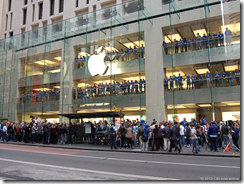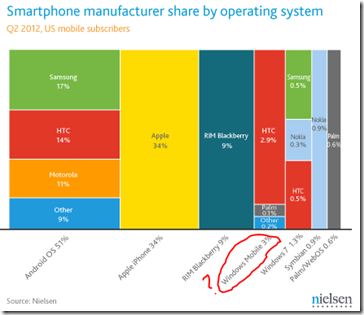 Scarcity strategy always end with abundance – maybe not from who you would expect. The end can be injected abundance from the same vendor through disruptive innovation and replacement of their own scarcity strategy. More often a new market entrant sees the opportunity to be disruptive, and takes the un-served market away from the original leader. Or, a partner jumps in, and shakes up the game with a collaborative strategy no one saw coming (read on).
Scarcity strategy always end with abundance – maybe not from who you would expect. The end can be injected abundance from the same vendor through disruptive innovation and replacement of their own scarcity strategy. More often a new market entrant sees the opportunity to be disruptive, and takes the un-served market away from the original leader. Or, a partner jumps in, and shakes up the game with a collaborative strategy no one saw coming (read on).
A few months ago, I wrote about Nokia and Microsoft’s launch strategy for the Lumia 900 and Windows phone OS. I was critical of two key points. First, their advertising was not resonating with buyers for this phone. And second, they tried to duplicate Apple’s original iPhone scarcity strategy with an exclusive AT&T channel partnership. Recent events make that last point worth revisiting.
Microsoft, Nokia Still Asleep At The Wheel
Domestically, here in the US, only this month, the Lumia phone product line is becoming available on Verizon and T-Mobile. And, there doesn’t appear to be a date for Sprint. In July, Business Insider reported that “Nokia may have only sold 330,000 Windows-powered Lumias” in the 4 months since launch. Nielsen in that same month reported that Windows Mobile had achieved only 3% of total smartphone manufacturer share by operating system at the end of Q2, 2012.
 Granted, these numbers are from July, and it is now 3 months later – but they haven’t changed much. Worth noting the market force that the iPhone 5 release, and Motorola acquisition by Google has in this battle for market share.
Granted, these numbers are from July, and it is now 3 months later – but they haven’t changed much. Worth noting the market force that the iPhone 5 release, and Motorola acquisition by Google has in this battle for market share.
Sure, we are seeing a shift in strategy, with an addition of T-Mobile and Verizon as channel partners for the Nokia and Microsoft combination. I can hear the critics of my line of thinking already saying, “all in due time.” I assert that just won’t work anymore as the dynamic dependencies that demand creates for a strategy of abundance were not well thought out by either Microsoft or Nokia – and now they are behind, and falling further back.
It Takes A Business Ecosystem
Apple attracted application developers when they were the only game in town. And, they could put developers through a rigorous “approval” process before allowing the app to be sold in the Apple app store. When you are the only hardware and software platform combination available, developers have only one choice, just like consumers had only one choice for consumer smartphones (RIM is/was corporate).
Today, though, for Microsoft and Nokia to drive demand for new apps, they have to have consumers with their phone hardware and operating system. You can’t accelerate consumer demand for apps by having an exclusive partner like AT&T, alone. And, now, many months later, Apple has released the iPhone 4 and the iPhone 5, increasing their leadership gap (look at the chart!) over the Microsoft Nokia offering. And subsequently this makes the decision for developers to stay on the iPhone, exclusively, an easy one.
Shift Scarcity Strategy To Abundance
What should Microsoft and Nokia do? They should lower hardware prices, or give hardware away in exchange for loyalty. This will drive market share, but more importantly, it will create market demand for apps on the Windows platform. This in turn will attract smartphone developers into the Microsoft Windows phone community. It will be a business decision for iPhone (and Android) app developers to shift platforms or add a second platform. Or entirely new developers will enter the market as they see the opportunity to compete. Right now, this is a static market. Folks at Microsoft have to learn that this isn’t Visual Studio of 15 years ago. It takes more than software development tools in this dynamic mobile OS and hardware market to attract developers that will drive demand – Microsoft and Nokia have to find a way to deliver consumer demand to them as well.
Perhaps Too Late
Today we learned the details of Japan’s Softbank to put $20billion into Sprint. Most yawn, and say this won’t help, or Softbank is picking the wrong horse to ride. Sprint has something that makes smartphones perform for consumers in terms of data, lots of it, at lower cost. The proposed deal is around Softbank enabling iPhone market expansion, both in terms of Sprint, but also in terms of markets that smartphones have not yet entered.
This is good for Apple, and bad for Nokia/Microsoft. It’s probably a no-op for Android/Google, since Sprint has their platform with Samsung in their stores now. Why is it good for Apple? Well, I suggest that the iPhone 5 will be the last time they advertise a launch showing long-wait lines standing around the block in the news for the new phone. Even this time around, demand for the iPhone was softer. Apple itself is shifting internally, to a strategy of abundance. Look out Microsoft and Nokia, Apple already knows that their scarcity play with the iPhone has run out.
[Did you notice that Apple ran this same strategy with the iPod!? They shifted subtly from a scarcity play with high-cost devices, to one of abundance, with lowering cost, higher capacity iPod music players. Apple extended the product line with purpose-built designs for sports, listening, integrating, and so on – that was the abundance play. Woops! why didn’t Nokia and Microsoft see the signs years ago? Perhaps they were too busy trying to make the Zune compete with the original iPod? That’s a rearward-looking strategy, but I certainly don’t know.]The Sprint deal is bad for AT&T, Verizon and T-Mobile as they don’t have the bandwidth to compete with the vast spectrum that Sprint collected over the years from acquisition of smaller cellular players. This is the reason Verizon, AT&T and T-Mobile have scaling prices for data plans (download more, pay more), and are trying to get customers off their unlimited plans. They are throttling data using price as a governor. Sprint’s unlimited plan, is truly unlimited – I have it, and know from experience.
If Sprint doesn’t have a Nokia/Microsoft offering to offer in this $20 billion expansion play, that original scarcity misstep that Nokia and Microsoft made with AT&T months ago – may be have been their final breath, as we look back. Oops!
Strategy Lessons Learned
When you enter into competition with the market leader, NEVER make the mistake of following in their footsteps with an undifferentiated repeat strategy. Thinking you can somehow “re-democratize” the same product that your competitor has already achieved commodity status with, is insanity. [Yes, if you are in version 5 with your product (iPhone 5) your product is a commodity.] Instead of following your competitor’s strategy of scarcity, leverage abundance to take market share, create consumer demand for apps, and build an at-the-ready partner ecosystem from those two steps.
It may be too late for Nokia and Microsoft to do this – with the Sprint/Softbank deal about to make the iPhone a super-commodity. That deal will increase volume which in turn will lower costs making it hard for Nokia and Microsoft to follow-suit.
As you read this, don’t think about Apple, Microsoft and Nokia – put this in perspective with your own business or enterprise and your competitors. How are you applying the strategy rules of scarcity and abundance. Leave a comment and share your anecdote.
Image Credits: 1) CBS Interactive, via c|net. 2) Nielsen, via Business Intelligence.










[…] See on steinvox.com […]
[…] Scarcity strategy always end with abundance – not always from where expected. The end may be a shift to abundance or disruptive innovation and game change. […]
[…] Scarcity strategy always end with abundance – not always from where expected. The end may be a shift to abundance or disruptive innovation and game change. […]